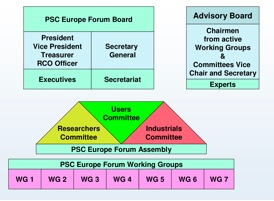| The PSCE Forum: a Public Safety Convergence Platform | | Print | |
|
Obstacles Among the obstacles presently hindering the building of an internationally integrated system are for example multi languages and the difficulty of localization of emergency calls. Also, the networks enabling the communication between the authorities and from authorities to the citizens are difficult to implement as harmonized systems due to different structures, cultures and policies of the various authorities. The diversity of technologies used by different European member states and user groups creates serious interoperability problems at different levels, starting from the level of equipment and going to the level of applications and user/system requirements. The interoperability problem dramatically reduces the efficiency of emergency response, especially in complex situations and /or in situations requiring coordinated international efforts. The increasing costs of new technologies and limited state budgets require careful evaluation of new systems at the tendering phase of new contracts’ negotiations. As a result, today a large number of diverse systems are used, but they cannot talk with each other efficiently. At the same time the small size of the public safety market makes it more difficult for manufactures and service providers to reduce their level of costs. The communication between authorities, from authorities to citizens and from citizens to authorities needs to be internationally harmonized. The only solution to this multidimensional problem is to internationally harmonize user requirements, systems and applications.
Harmonization is a complex process... Harmonization is a complex process that requires the involvement of different key players at the international level and could continue for long periods of time. The key element of convergence will be the creation of an internationally accepted roadmap that will contain a vision of future requirements, identify areas for further research, identify methods and technologies that will integrate legacy systems and identify emerging technologies that could be used in civil protection/public safety service delivery and that can be used to influence policy makers, regulators and standard making bodies. Stakeholders involved in these problems, namely users providing emergency and disaster response, industry providing equipment and services, researchers developing new ideas and concepts and organizations defining standards for cooperation frameworks will be brought together within PSCE Forum. Convergence, at international level, of requirements formulated by each of them, is an essential goal of the project in order to lay the ground for possible solutions. The NARTUS project established a Forum for regular exchange of ideas, information, experiences and best practices, and on seeking agreement among participating stakeholders.
The PSCE Forum The PSCE Forum consists of the following structural elements:
The approved model structure for PSC Europe Forum comprises four Committees, one for each of the stakeholders’ groups:
This structure ensures the user’s request for “privacy” when discussing public safety issues, but gives also the other stakeholder groups the same authority. However, the main discussions will take place in the Forum, in order to fulfil the objective of an all-stakeholder Forum for Public Safety Communications. In June 2009, the PSCE Forum had 581 registrants from 54 different countries and representing all stakeholders (139 users, 226 industrials, 216 researchers).The PSCE Forum was established as an independent legal entity (non-profit international association)in Belgium in June 2009.
|
